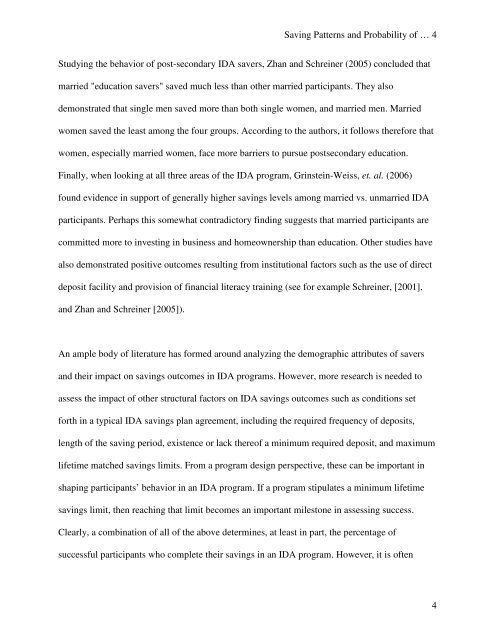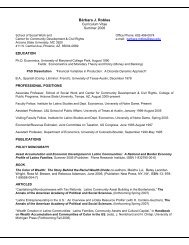Saving Patterns and Probability of Success in Individual ...
Saving Patterns and Probability of Success in Individual ...
Saving Patterns and Probability of Success in Individual ...
You also want an ePaper? Increase the reach of your titles
YUMPU automatically turns print PDFs into web optimized ePapers that Google loves.
<strong>Sav<strong>in</strong>g</strong> <strong>Patterns</strong> <strong>and</strong> <strong>Probability</strong> <strong>of</strong> … 4<br />
Study<strong>in</strong>g the behavior <strong>of</strong> post-secondary IDA savers, Zhan <strong>and</strong> Schre<strong>in</strong>er (2005) concluded that<br />
married "education savers" saved much less than other married participants. They also<br />
demonstrated that s<strong>in</strong>gle men saved more than both s<strong>in</strong>gle women, <strong>and</strong> married men. Married<br />
women saved the least among the four groups. Accord<strong>in</strong>g to the authors, it follows therefore that<br />
women, especially married women, face more barriers to pursue postsecondary education.<br />
F<strong>in</strong>ally, when look<strong>in</strong>g at all three areas <strong>of</strong> the IDA program, Gr<strong>in</strong>ste<strong>in</strong>-Weiss, et. al. (2006)<br />
found evidence <strong>in</strong> support <strong>of</strong> generally higher sav<strong>in</strong>gs levels among married vs. unmarried IDA<br />
participants. Perhaps this somewhat contradictory f<strong>in</strong>d<strong>in</strong>g suggests that married participants are<br />
committed more to <strong>in</strong>vest<strong>in</strong>g <strong>in</strong> bus<strong>in</strong>ess <strong>and</strong> homeownership than education. Other studies have<br />
also demonstrated positive outcomes result<strong>in</strong>g from <strong>in</strong>stitutional factors such as the use <strong>of</strong> direct<br />
deposit facility <strong>and</strong> provision <strong>of</strong> f<strong>in</strong>ancial literacy tra<strong>in</strong><strong>in</strong>g (see for example Schre<strong>in</strong>er, [2001],<br />
<strong>and</strong> Zhan <strong>and</strong> Schre<strong>in</strong>er [2005]).<br />
An ample body <strong>of</strong> literature has formed around analyz<strong>in</strong>g the demographic attributes <strong>of</strong> savers<br />
<strong>and</strong> their impact on sav<strong>in</strong>gs outcomes <strong>in</strong> IDA programs. However, more research is needed to<br />
assess the impact <strong>of</strong> other structural factors on IDA sav<strong>in</strong>gs outcomes such as conditions set<br />
forth <strong>in</strong> a typical IDA sav<strong>in</strong>gs plan agreement, <strong>in</strong>clud<strong>in</strong>g the required frequency <strong>of</strong> deposits,<br />
length <strong>of</strong> the sav<strong>in</strong>g period, existence or lack there<strong>of</strong> a m<strong>in</strong>imum required deposit, <strong>and</strong> maximum<br />
lifetime matched sav<strong>in</strong>gs limits. From a program design perspective, these can be important <strong>in</strong><br />
shap<strong>in</strong>g participants’ behavior <strong>in</strong> an IDA program. If a program stipulates a m<strong>in</strong>imum lifetime<br />
sav<strong>in</strong>gs limit, then reach<strong>in</strong>g that limit becomes an important milestone <strong>in</strong> assess<strong>in</strong>g success.<br />
Clearly, a comb<strong>in</strong>ation <strong>of</strong> all <strong>of</strong> the above determ<strong>in</strong>es, at least <strong>in</strong> part, the percentage <strong>of</strong><br />
successful participants who complete their sav<strong>in</strong>gs <strong>in</strong> an IDA program. However, it is <strong>of</strong>ten<br />
4














